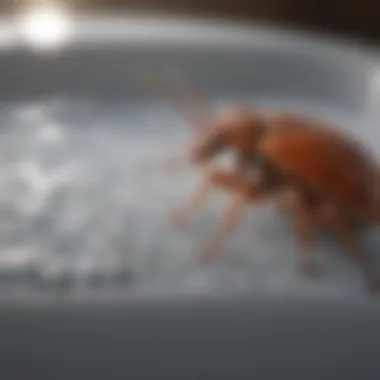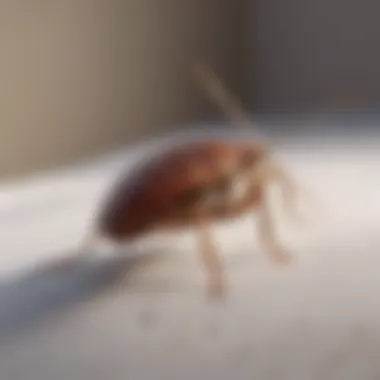The Impact of Hot Water Washing on Eradicating Bed Bugs: A Comprehensive Analysis


Preventive Pest Control Strategies
When it comes to effectively managing and preventing pest infestations, implementing robust preventive pest control strategies is essential. These strategies encompass various aspects of household maintenance and care to create an environment that is unattractive to pests. One crucial aspect of preventive pest control is maintaining the house exterior. This involves tips for sealing cracks, clearing debris that may harbor pests, and establishing barriers to prevent pests from entering the home.
In addition to house exterior protection, yard maintenance plays a vital role in pest control. Essential yard care routines such as regular mowing and trimming can help eliminate pest habitats. Moreover, implementing methods to keep the yard pest-free, such as using natural repellents or traps, adds an extra layer of defense against potential infestations.
Maintaining indoor cleanliness is another key component of effective pest control. Expert cleaning tips and techniques, such as regular vacuuming, decluttering, and proper storage of food items, contribute to creating a pest-resistant indoor environment. Additionally, proper garbage disposal practices are crucial in preventing pests from being attracted to the household. Efficient waste disposal methods, such as sealing garbage bags tightly and disposing of trash regularly, help minimize pest access to food sources.
Lastly, exploring other pest prevention strategies beyond the conventional methods can provide innovative ways to safeguard your home. This can involve using natural deterrents, implementing smart storage solutions, or even considering pest-resistant plant species in your garden. By incorporating a combination of these strategies, you can establish a comprehensive approach to pest prevention and control.
Introduction
Understanding Bed Bugs
Overview of Bed Bugs
When exploring the realm of bed bug infestations, gaining an insight into the nature of these pests is fundamental. Bed bugs, scientifically known as Cimex lectularius, are tiny, reddish-brown insects that feed on the blood of warm-blooded animals, particularly humans. Their nocturnal habits and cryptic behavior make them challenging to detect and eliminate, making them a resilient adversary in the realm of pest control. Understanding the behavioral patterns and physical characteristics of bed bugs is paramount in devising effective eradication strategies.
Life Cycle of Bed Bugs
Exploring the life cycle of bed bugs unveils their remarkable ability to proliferate and adapt in various environments. The life cycle consists of multiple stages, including egg, nymph, and adult phases, each with distinct characteristics and vulnerabilities. By understanding the developmental stages of bed bugs, one can target them at their most susceptible points, enhancing the efficacy of control measures. Recognizing the resilience and adaptability of bed bugs throughout their life cycle is crucial in formulating a comprehensive approach to eradicate infestations.
Challenges of Bed Bug Infestations
Resilience of Bed Bugs
The resilience of bed bugs against traditional pest control methods poses a significant challenge for households and professional exterminators alike. Bed bugs have developed resistance to many pesticides over time, making chemical treatments less effective. Their ability to hide in crevices and reproduce rapidly enhances their survival rate, necessitating innovative strategies for their eradication. Addressing the resilience of bed bugs requires a multi-faceted approach that integrates various control methods to achieve sustainable results.
Impact on Health and Well-being


Beyond the physical nuisance they cause, bed bugs have a profound impact on the mental and emotional well-being of individuals. Their presence can lead to anxiety, sleep disturbances, and skin irritations, compromising the overall quality of life. Furthermore, the stigma associated with bed bug infestations can result in social isolation and financial burdens. Recognizing the holistic impact of bed bug infestations on health and well-being is essential in advocating for proactive management and prevention strategies.
Temperature Requirements
Temperature requirements play a crucial role in the effectiveness of eradicating bed bugs through hot water washing, making it a fundamental aspect to consider in this comprehensive guide. Understanding the ideal temperature for killing bed bugs is essential to ensure the method's success. The precise temperature settings dictate the success rate of eliminating bed bugs from clothes and fabrics.
Ideal Temperature to Kill Bed Bugs
When delving into the ideal temperature to kill bed bugs, it becomes evident that research findings offer valuable insights. Research findings provide concrete data on the temperatures required to effectively eradicate bed bugs during the washing process. These findings shed light on the specific temperature range that is most lethal to bed bugs, ensuring thorough elimination. The key characteristic of these research findings lies in their scientific rigor and empirical evidence, making them a reliable choice for guiding bed bug control practices. The unique feature of research findings is their ability to quantify the impact of temperature on bed bugs, providing measurable outcomes for efficient bug removal from fabrics.
Research Findings
Research findings highlight the significance of precise temperature control in hot water washing for bed bug elimination. By specifying the exact temperature ranges that are lethal to bed bugs, these findings offer practical guidance for households dealing with infestations. The benefit of incorporating research findings into this article is the credibility and evidence-based approach they bring to the discussion. Additionally, they serve as a foundation for establishing best practices in eradicating bed bugs through hot water washing.
Expert Recommendations
Expert recommendations serve as valuable guidance in determining the ideal temperature for killing bed bugs effectively. Experts in the field of pest control provide insights into the temperature thresholds that yield optimal results in bed bug extermination through hot water washing. Their recommendations are based on extensive experience and knowledge, making them a trusted resource for households combatting bed bug infestations. The advantage of following expert recommendations lies in the expert-backed strategies that enhance the efficiency of hot water washing in eliminating bed bugs from clothes and linens.
Variations in Temperature Effects
Exploring the variations in temperature effects showcases the diverse impacts of heat exposure on different bed bug stages and the duration of exposure. Understanding these variations is critical in maximizing the efficacy of hot water washing as a bed bug control method.
Influence on Different Bed Bug Stages
The influence of temperature on different bed bug stages reveals insights into the vulnerabilities of bed bugs at various developmental phases. Heat exposure affects eggs, nymphs, and adult bed bugs differently, necessitating precise temperature adjustments for comprehensive eradication. By targeting the unique vulnerabilities of each bed bug stage, hot water washing becomes a more thorough and effective approach to eliminating infestations. The advantage of considering these variations lies in their applicability to tailored bed bug control strategies based on the specific stage distribution in infested materials.
Duration of Exposure
The duration of exposure to hot water is a critical factor in determining the success of bed bug elimination. Research indicates that prolonged exposure to high temperatures is essential for ensuring the death of bed bugs across all life stages. The key characteristic of exposure duration is its direct correlation with the effectiveness of hot water washing in eradicating bed bugs. By understanding the importance of exposure duration, households can optimize their laundry practices to achieve maximum efficacy in eliminating bed bugs from textiles and garments.
Hot Water Washing


In the realm of eradicating bed bugs, hot water washing stands out as a crucial technique that housewives can employ with precision. This section delves into the significance of hot water washing within the context of efficiently eliminating bed bugs from clothes. Hot water washing is a cornerstone method in bed bug control due to its proven efficacy in killing bed bugs at various life stages. By understanding the specific elements and benefits of hot water washing, housewives can implement a strategic approach to tackle bed bug infestations effectively. Moreover, considering the practical considerations associated with hot water washing is essential to optimize the process and ensure comprehensive eradication of bed bugs.
Mechanism of Action
Impact of Heat on Bed Bugs
The impact of heat on bed bugs is a critical aspect of hot water washing that drives its effectiveness in bed bug control. Heat poses a potent threat to bed bugs by disrupting their cellular structure and metabolic processes, ultimately leading to their demise. The key characteristic of heat's impact is its ability to penetrate the exoskeleton and internal organs of bed bugs, delivering lethal effects throughout their bodies. This characteristic makes heat an advantageous choice for this article as it ensures thorough elimination of bed bugs across all life stages. While the unique feature of heat's impact on bed bugs lies in its direct and rapid action, it may have limitations in reaching hidden or hard-to-access areas where bed bugs reside.
Penetration of Heat in Fabrics
When exploring the penetration of heat in fabrics, it becomes evident that this aspect is crucial in ensuring the success of hot water washing in eliminating bed bugs. Heat penetrates fabrics deeply, reaching crevices and folds where bed bugs might seek refuge. The key characteristic of heat penetration is its ability to spread evenly throughout fabrics, leaving no corner untouched and maximizing the chances of eradicating bed bugs completely. This characteristic makes heat penetration a popular choice for this article as it guarantees thorough extermination of bed bugs residing in clothes. The unique feature of heat penetration lies in its ability to target bed bug eggs, larvae, and adult insects alike, offering a comprehensive solution to infestations. However, it is essential to note that improper heat distribution or inadequate exposure time may limit the effectiveness of heat penetration in fabrics.
Effectiveness Assessment
Studies on Hot Water Washing
Delving into studies on hot water washing unveils valuable insights into the efficacy of this method in killing bed bugs. Research findings consistently demonstrate the high success rate of hot water washing in eradicating bed bugs, making it a beneficial choice for housewives dealing with infestations. The key characteristic of these studies is their emphasis on specific temperature requirements and exposure durations that guarantee optimal results in bed bug elimination. This characteristic enhances the credibility of hot water washing as a reliable bed bug control method. The unique feature of these studies lies in their ability to provide evidence-based recommendations on water temperature settings and laundry practices that ensure maximum effectiveness against bed bugs. While the advantages of hot water washing are abundant, it is essential to follow expert guidelines closely to derive maximum benefits.
Real-world Application
Examining the real-world application of hot water washing sheds light on its practicality and usability for housewives combating bed bug infestations. Real-world scenarios highlight the seamless integration of hot water washing into daily laundry routines as an effective bed bug control measure. The key characteristic of real-world application is its versatility in accommodating different fabric types and washing machine settings, making it a popular choice among households. This characteristic underscores the convenience and accessibility of hot water washing in practical bed bug management. The unique feature of real-world application lies in its adaptability to various living situations and fabric sensitivities, providing a tailored approach to each household’s specific needs. While the advantages of real-world application are significant, ensuring consistency and adherence to recommended protocols is crucial for sustained success in eliminating bed bugs through hot water washing.
Practical Considerations
Practical considerations play a crucial role in the efficacy of washing clothes in hot water to eliminate bed bugs. It is essential to optimize hot water laundry processes to ensure effective bed bug control. By focusing on specific elements such as water temperature settings and precautions for delicate fabrics, individuals can enhance the success of this method. Understanding the intricacies of these practical considerations is key to achieving optimal results in eliminating bed bugs.
Optimizing Hot Water Laundry
Water Temperature Settings
When discussing water temperature settings, the precision and control of the heat are fundamental. Utilizing specific temperatures that align with research findings and expert recommendations is vital to ensuring bed bugs are eradicated effectively. The key characteristic of water temperature settings lies in their ability to reach temperatures known to kill bed bugs while being a popular choice due to their proven efficacy. The unique feature of water temperature settings is their direct impact on the penetration of heat into fabrics, ensuring that bed bugs at different life stages are effectively targeted. Despite the advantages in killing bed bugs, a key consideration is the potential risk of damage to more delicate fabrics, highlighting the importance of balancing heat intensity with fabric safety.


Precautions for Delicate Fabrics
Precautions for delicate fabrics are a critical aspect of optimizing hot water laundry. By taking necessary precautions to protect more sensitive materials during the washing process, individuals can prevent damage while still effectively targeting bed bugs. The key characteristic of precautions for delicate fabrics is their focus on maintaining fabric integrity while eliminating bed bugs, making them a popular choice for those with varying fabric types. The unique feature of these precautions is their ability to provide a balance between effective bed bug control and fabric preservation. However, potential disadvantages may include longer washing times or the need for specialized detergents, underscoring the importance of assessing individual fabric needs when implementing this approach.
Supplementary Bed Bug Control Methods
Complementary Strategies
Complementary strategies offer additional support in bed bug control efforts. By combining hot water washing with complementary methods such as mattress encasements or residual insecticides, individuals can create a more comprehensive approach to tackling bed bug infestations. The key characteristic of complementary strategies is their ability to target bed bugs from multiple angles, providing a holistic solution to infestation problems. Their unique feature lies in their versatility, allowing for customization based on the severity of the infestation and individual preferences. While advantageous in enhancing overall bed bug control, a potential disadvantage may include the need for regular maintenance or additional costs, highlighting the importance of weighing the benefits against the associated efforts.
Professional Pest Control Assistance
Professional pest control assistance can be a valuable resource in addressing severe bed bug infestations. By seeking the expertise of pest control professionals, individuals can benefit from specialized treatment plans and thorough inspections to eliminate bed bugs effectively. The key characteristic of professional pest control assistance is their in-depth knowledge and experience in handling bed bug infestations, making them a popular choice for complex cases. The unique feature of this assistance is their access to professional-grade tools and techniques, ensuring a high level of efficacy in eradicating bed bugs. However, potential disadvantages may include higher costs or the need for multiple treatment sessions, emphasizing the importance of considering professional assistance for particularly stubborn infestations.
Conclusion
In the realm of eradicating bed bugs, the conclusion serves as a pivotal summary encapsulating the essence of washing clothes in hot water. Clear and detailed evaluations of methodologies are crucial to discern the efficacy of hot water washing. Highlighting the significance of this process lies not only in its immediate impact but also in fostering long-term strategies for effective bed bug control. Understanding the importance of diligence in laundry practices can significantly mitigate recurring infestations.
Summarizing the Findings
Efficacy of Hot Water Washing
Emphasizing the meticulous approach of hot water washing towards bed bug elimination, this method stands out for its thoroughness and effectiveness in targeting both adult bugs and their eggs. The key characteristic of hot water washing is its ability to penetrate fabrics deeply, ensuring a comprehensive eradication process. The unique feature of this method lies in its non-toxic nature, making it a sustainable and environmentally friendly choice for bed bug management. While its advantages include cost-effectiveness and simplicity, drawbacks may include potential fabric damage if not approached with care.
Integration into Bed Bug Management
Integration of hot water washing into broader bed bug management strategies enhances the overall effectiveness of pest control measures. The key characteristic of this integration is its ability to complement other treatment methods, creating a multi-faceted approach towards complete eradication. Its unique feature lies in its accessibility and ease of implementation, making it a popular choice among households combating bed bug infestations. Advantages include its affordability and non-reliance on harsh chemicals, but potential disadvantages may include the need for consistent application to achieve desired results.
Future Implications
Potential Research Directions
Exploring potential research directions in hot water washing reinforces the continuous evolution of methodologies in combating bed bug infestations. The key characteristic of research in this area is its scope for innovation, potentially leading to more sustainable and efficient techniques. The unique feature of delving into this field lies in the opportunity to refine existing practices and discover novel solutions. Advancements can offer advantages such as increased efficacy and convenience, yet challenges may include resource-intensive studies and time-consuming experimentation.
Public Health Significance
Understanding the public health significance of hot water washing underscores its broader impact on community well-being and disease prevention. The key characteristic of its significance lies in its role in reducing the spread of bed bugs and associated health risks. This method's unique feature is its proactive approach towards safeguarding public health, aligning with sustainable pest control practices. Advantages encompass a decrease in potential health hazards and public health expenditures, while potential disadvantages may involve initial cost investments and the need for widespread education on its benefits.



